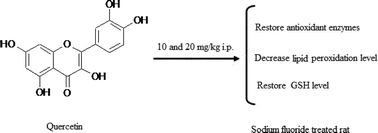Protective effect of quercetin against sodium fluoride induced oxidative stress in rat's heart
Abstract
The antioxidative and cardioprotective properties of

* Corresponding authors
a
Applied Biotechnology Research Center, Baqiyatallah University of Medical Sciences, Tehran, Iran
E-mail:
Nabavi208@gmail.com
Fax: +98 21 22823734
Tel: +98 21 22823734
b National lites foundation of Iran, Tehran, Iran
c Department of Biology, Faculty of Basic Science, University of Mazandaran, Babolsar, Iran
The antioxidative and cardioprotective properties of

 Please wait while we load your content...
Something went wrong. Try again?
Please wait while we load your content...
Something went wrong. Try again?
S. F. Nabavi, S. M. Nabavi, M. Mirzaei and A. H. Moghaddam, Food Funct., 2012, 3, 437 DOI: 10.1039/C2FO10264A
To request permission to reproduce material from this article, please go to the Copyright Clearance Center request page.
If you are an author contributing to an RSC publication, you do not need to request permission provided correct acknowledgement is given.
If you are the author of this article, you do not need to request permission to reproduce figures and diagrams provided correct acknowledgement is given. If you want to reproduce the whole article in a third-party publication (excluding your thesis/dissertation for which permission is not required) please go to the Copyright Clearance Center request page.
Read more about how to correctly acknowledge RSC content.
 Fetching data from CrossRef.
Fetching data from CrossRef.
This may take some time to load.
Loading related content
